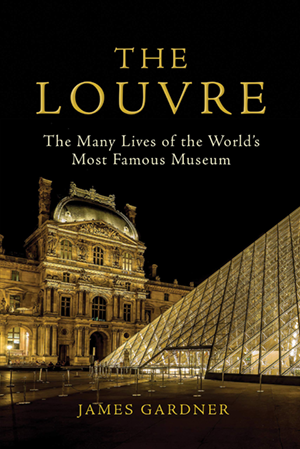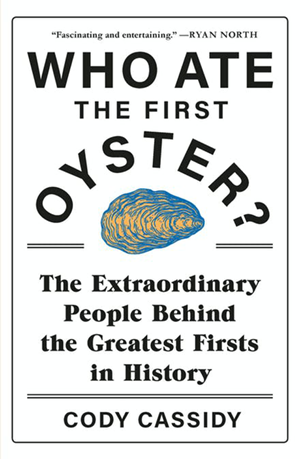A Notorious 17th-Century Pirate, the Many Lives of the Louvre and Other New Books to Read
The seventh installment in our weekly series spotlights titles that may have been lost in the news amid the COVID-19 crisis
:focal(807x464:808x465)/https://tf-cmsv2-smithsonianmag-media.s3.amazonaws.com/filer/9e/ff/9eff4a90-e734-48d0-925b-7bb64f40efdf/booksweek7.png)
When Captain Henry Every and his crew of marauders ambushed the pride of the Mughal fleet in September 1695, they set in motion an international crisis with lasting implications. As Steven Johnson, author of The Ghost Map and How We Got to Now, writes in Enemy of All Mankind: A True Story of Piracy, Power, and History's First Global Manhunt, Every’s capture of the Ganj-i-Sawai—and its trove of an estimated $200 million in gold, silver and jewels—led the British East India Company to take harsh retaliatory measures. In doing so, Johnson argues, the corporation and Every inadvertently sparked the birth of a modern phenomenon: multinational capitalism.
The latest installment in our “Books of the Week” series, which launched in late March to support authors whose works have been overshadowed amid the COVID-19 pandemic, details the search for Every, the many lives of the Louvre, the Montgomery bus boycott, the humans behind history’s greatest firsts and a titan of industry’s ideological clash with Theodore Roosevelt.
Representing the fields of history, science, arts and culture, innovation, and travel, selections represent texts that piqued our curiosity with their new approaches to oft-discussed topics, elevation of overlooked stories and artful prose. We’ve linked to Amazon for your convenience, but be sure to check with your local bookstore to see if it supports social distancing-appropriate delivery or pickup measures, too.
Enemy of All Mankind: A True Story of Piracy, Power, and History’s First Global Manhunt by Steven Johnson
/https://tf-cmsv2-smithsonianmag-media.s3.amazonaws.com/filer/ac/88/ac88fee8-e6b4-4b68-abab-26e9ef977739/enemy_of_all_mankind.png)
By all accounts, the Ganj-i-Sawai should’ve emerged victorious against the Fancy, a comparatively underequipped privateer ship. But luck was on Every’s side when the vessels met, and as Kirkus notes in its review of Enemy of All Mankind, Grand Mughal Aurangzeb’s flagship experienced a cannon misfire “even as a lucky shot from the pirate fleet took down the main mast.” Upon boarding the Ganj-i-Sawai, Every and his crew raped its women, tortured and murdered its men, and looted its treasure trove of goods.
The incident left the East India Company—and its trading interests in the Asian country—in a challenging position. Accused by Aurangzeb and his followers of hailing from a “nation of pirates” simply because Every was also British, the company teamed up with the crown to launch what Johnson deems the “first global manhunt.” Ultimately, the search proved only partially successful. Every escaped the hangman’s noose, though several of his comrades were captured and executed.
Despite this apparent failure, Johnson argues that the manhunt ushered in a much-needed reckoning between a soon-to-be outdated mode of money-making (autocracy funded by tithes, taxes and other forms of exploitation) and the way of the future: “a multinational corporation making money by trading goods with other nations, with shareholders profiting not just from the income generated, but also by the rising share price of the company itself.”
The Louvre: The Many Lives of the World’s Most Famous Museum by James Gardner

The Louvre is perhaps best known today as the home of Leonardo da Vinci’s Mona Lisa. But the palatial complex boasted a rich history long before the world’s most famous painting graced its walls. As James Gardner writes in his extensive exploration of the Parisian cultural institution—which he deems “as great a work of art as anything it contains”—the Louvre’s story actually stretches back some 7,000 years. “Before the Louvre was a museum,” the art critic explains in the book’s introduction, “it was a palace, and before that a fortress, and before that a plot of earth, much like any other.”
In 1191, French king Philippe Auguste ordered the construction of a defensive stronghold on the banks of the Seine River. Thousands of years earlier, according to Gardner, the site had served first as a campground and then as the home of a clay quarry and vineyard. During the 13th century, Charles V converted the fortress into a castle, laying the foundations for 16th-century king Francis I’s adoption of it as his main residence. But when Louis XIV chose Versailles as the main royal palace in 1682, the Louvre underwent a century of neglect. Finally, in 1793, the property assumed the role it holds to this day, opening as a public museum filled with art and artifacts—the majority of which were seized from France’s nobility amid the chaos of the French Revolution.
Writes Gardner, “What we see today is the result of no fewer than twenty distinct building campaigns that drew on the very diverse and unequal talents of scores of architects over eight centuries.”
Daughter of the Boycott: Carrying On a Montgomery Family’s Civil Rights Legacy by Karen Gray Houston
/https://tf-cmsv2-smithsonianmag-media.s3.amazonaws.com/filer/ac/66/ac662a6c-e976-4fd9-9233-b0b8408ca385/daughter_of_the_boycott.png)
Fred and Thomas Gray played pivotal roles in the civil rights movement, aiding the organization of the Montgomery bus boycott and battling segregation in court, respectively. In Daughter of the Boycott, journalist Karen Gray Houston reflects on her relatives’ legacy, detailing how her father, Thomas—a founding member of the Montgomery Improvement Association—“drove his car to pick up black passengers to keep them off the buses [and] make the boycott a success,” while his younger brother, Fred, spearheaded legal cases that expanded voting rights and “desegregated transportation, schools, housing, and public accommodations.”
In addition to discussing her father’s and uncle’s work, Houston draws on interviews with individuals including the daughter-in-law of the manager whose bus line was targeted by protesters and the son of Aurelia Browder Coleman, lead plaintiff in the Browder v. Gayle Supreme Court case that resulted in the desegregation of Montgomery’s buses. According to Kirkus’ review of Daughter of the Boycott, Houston’s “real coup” is a conversation with fellow Browder plaintiff Claudette Colvin, who refused to yield her seat to a white passenger nine months before Rosa Parks famously did the same.
Who Ate the First Oyster?: The Extraordinary People Behind the Greatest Firsts in History by Cody Cassidy

To gain a better understanding of the individuals behind history’s “greatest firsts,” science writer Cody Cassidy interviewed more than 100 experts, started a fire with flint and pyrite, shaved his face with a piece of obsidian, and brewed beer using spoiled gruel. This unconventional research method ultimately yielded insights on 17 historical innovators whose accomplishments range from eating the first oyster to discovering soap, painting the world’s first masterpiece, inventing clothing and performing the first surgery.
Among the many curiosities highlighted in the book: The first person whose name survives in the historical record is an accountant named Kushim who lived some 5,000 years ago. A young Australopithecus mother crafted the world’s first invention—a baby sling—approximately three million years ago. And the creator of clothing, a Homo sapien the author nicknames Ralph, invented fashionable attire not for protection, warmth or modesty, but as decoration.
Cassidy’s sweeping exploration is limited by the simple fact that the individuals featured “lived before or without writing.” Still, he writes in the book’s introduction, “These are people who scholars know existed and whose extraordinary or fateful acts are the foundation of modern life.”
The Hour of Fate: Theodore Roosevelt, J.P. Morgan, and the Battle to Transform American Capitalism by Susan Berfield
/https://tf-cmsv2-smithsonianmag-media.s3.amazonaws.com/filer/51/28/512872b0-bdfd-433e-971f-90bad87b14a9/the_hour_of_fate.png)
As Publishers Weekly notes in its review of journalist Susan Berfield’s debut book, Theodore Roosevelt and financier J.P. Morgan both hailed from upper-class families and endured childhoods marred by illness. Despite these similarities, the pair vehemently disagreed on political and economic issues: Whereas Roosevelt argued that big business “had to be accountable to the public,” according to Berfield, Morgan believed capitalism should operate unchecked by all except titans of industry.
These conflicting views came to a head on September 14, 1901, when President William McKinley’s assassination made his vice president, Roosevelt, the United States’ new commander in chief. Roosevelt and Morgan, who at the time was among the richest men in the nation, viewed each other with distrust and uncertainty. When Morgan reportedly said, “I am afraid of Mr. Roosevelt because I don’t know what he’ll do,” the president replied, “He’s afraid of me because he does know what I’ll do.”
The Hour of Fate’s main action unfolds in 1902, when the government accused Morgan’s Northern Securities of antitrust violations, only to be stymied by a coal mining union strike that left both the railroad industry and the country, which relied on coal to heat its citizens’ homes, in a precarious position.
Writes Berfield, “With millions of dollars on the line, winter bearing down, and revolution in the air, it was a crisis that neither man alone could solve.”
/https://tf-cmsv2-smithsonianmag-media.s3.amazonaws.com/accounts/headshot/mellon.png)
/https://tf-cmsv2-smithsonianmag-media.s3.amazonaws.com/accounts/headshot/mellon.png)